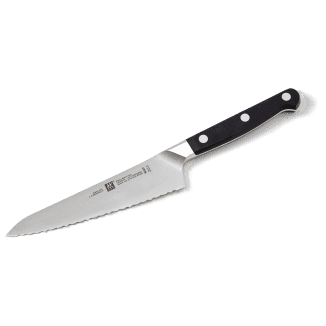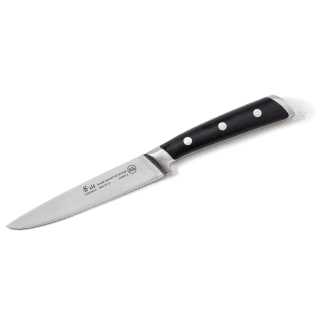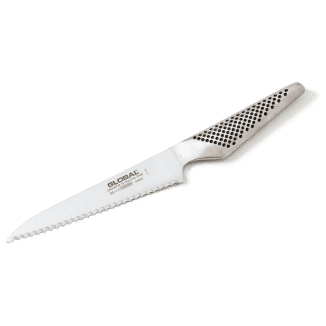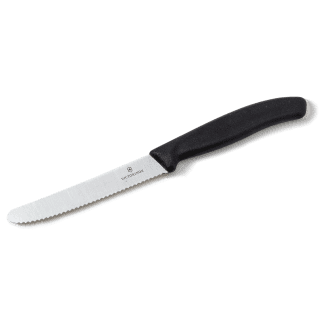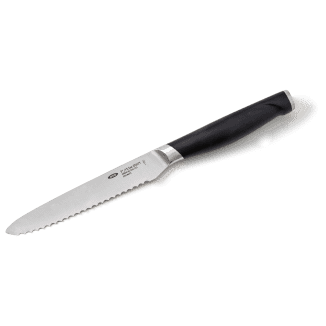While the term “utility knife” might conjure up images of box cutters or hunting knives, it can also describe a handy all-purpose knife meant exclusively for kitchen use. Sizewise, utility knives fall somewhere between a paring knife and a chef’s knife, with a blade that’s usually between 5 and 6 inches long; they come in both straight-bladed and serrated styles. We’d never focused on these knives exclusively in a full testing before, and we wondered if they’d perform any task better than the knives most home cooks already have in their kitchens. We were particularly interested in the serrated models. While our favorite serrated knife, the Mercer Culinary Millennia 10" Wide Bread Knife, is great for cutting everything from large loaves of bread to delicate layer cakes, its long blade sometimes feels like overkill when we’re slicing just a tomato or a salami. We were intrigued by the prospect of a more compact serrated knife that could be used for these smaller tasks. We bought eight serrated utility knives, priced from about $7.50 to about $110.00, and used them to slice tomatoes, baguettes, kaiser rolls, and salami and to quarter avocados and loaded BLT sandwiches.

Blade Sharpness Is Paramount
Contrary to their name, these utility knives varied significantly in terms of serration, blade shape, and handle size. The knives performed quite differently, too, with some cutting cleanly and others making more ragged, uneven slices. What made certain knives better than others?
Certain features that had been critical in our serrated knife testing—such as the number of serrations and their shape—proved less important with the serrated utility knives, perhaps because we use these knives for smaller, less difficult tasks. But if the serrations weren’t critical, what was?

As it turned out, the sharpness of the blade was the single most important factor in determining our preferences. Serrated knives are harder to sharpen at home than straight blades are, so it’s critical to have one that is sharp from the get-go. In theory, the sharpness of any blade is dictated by its edge angle—an angle that was actually fairly uniform (15 or 16 degrees) across the knives we tested, at least as reported by the manufacturers. In practice, however, knives can be sharpened incorrectly or incompletely at the factory, resulting in blades with improper (or inconsistent) angles or blades that have coarser edges that drag against food instead of slicing it fluidly.
Indeed, not all the knives were sharp from the start. When we initially tested their blades by using them to cut tomatoes, some just couldn’t make clean slices, leaving ragged edges or failing to slice through the bottom of the fruit. These knives also faltered when we used them to split kaiser rolls, ripping the soft bread a bit instead of halving them precisely; when we cut loaded BLTs with these dull knives, we had to slice down carefully, not saw, or else the bread would go one way and the tomatoes another. The problems weren’t just aesthetic, either: We had to work harder to force dull blades through dense salami and crusty baguettes, whereas sharp blades easily moved through the food. At least edge retention wasn’t a problem: When we repeated the tomato test at the conclusion of testing, none of the knives was significantly duller than at the outset.

Blade Dimensions Matter, As Does A Sharp Tip
A few other factors also contributed to our preferences. First, the serrated length of the blade. We preferred blades with a total serrated length of about 5 inches—about half the length of the blade on our favorite large serrated knife. Blades with longer serrated lengths felt a bit oversize when handling baguettes and salami, and blades with shorter serrated lengths were too small to easily halve large avocados and kaiser rolls.
Most blades had no serrations at the tip and the heel. Our science research editor explained that this lack of serrations helps to strengthen the blade and decrease the likelihood that the final serrations will chip or bend while in use. Smooth-edged tips allowed us to do detail work; we preferred tips that were narrow and pointed to those that were big and/or rounded, as they made it easier to core tomatoes or dig out avocado stems.
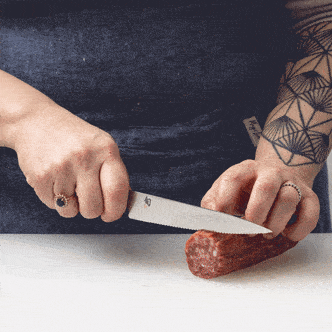

We liked blades that were wedge-shaped—taller at the heel and tapering to a narrow tip. Several blades were consistently narrow from heel to tip, resembling oversize nail files; since these blades were short at the heel, our knuckles hit the cutting board at around the same time the blades did, making for awkward slicing.
We also preferred blades that were moderately thick and rigid; blades that were thin from edge to spine were a tad too flexible, buckling and making us work harder to direct them in a straight line when we tried to cut dense salami or crusty bread into even slices.

Handle Dimensions Are Important, Too
Finally, we considered handle design. We liked models with handles that were about 4.5 inches long. Shorter handles cramped large hands, and much larger ones felt oversize and unwieldy. We also liked handles that weren’t too thick all the way around; those with a circumference of more than 2.75 inches were awkward and uncomfortable to grip. We preferred those that were made of slightly textured materials, as metal and smoother plastics were a little more slippery to grip.
The Best Serrated Utility Knife: The Zwilling Pro 5.5" Serrated Prep Knife
Our favorite serrated utility knife is the Zwilling Pro 5.5" Serrated Prep Knife. Its blade features 5 inches of scalloped and pointed serrations, providing the perfect amount of power and grip when we cut food. A narrow tip let us core tomatoes easily, and a relatively tall heel gave our hands plenty of clearance as we cut. Best of all, it’s razor-sharp. A few testers thought the handle could have been a touch longer and thicker, but most found it comfortable to use. At about $100.00, it’s not cheap, but we think it would make a wonderful supplement to your knife collection—it made quick work of all the smaller tasks for which we wouldn’t want to pull out a large serrated knife. For a less expensive option, you might consider the Cangshan TS Series 5-Inch Serrated Utility Knife and Wood Sheath Set, at about half the price. Its blade has a less pronounced taper and a shorter serrated length than our winner, but it was relatively stiff and supersharp, making for great cutting. And we loved that it came with its own magnetic sheath for safe and effective storage.
- Sharp, stiff blade with serrated length of about 5 inches
- Wedge-shaped blade: tall at heel, narrow at tip
- A combination of both pointed and scalloped teeth
- Handle of moderate length and circumference
- Eight knives, priced from about $7.50 to about $110.00
- Slice tomatoes at beginning and end of testing to gauge sharpness
- Slice baguettes
- Slice salami
- Halve kaiser rolls
- Quarter avocados
- Quarter loaded BLT sandwiches
- Have users of different hand sizes and dominant hands use each knife

